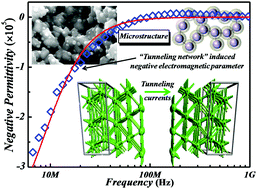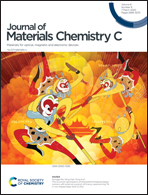Tunneling-induced negative permittivity in Ni/MnO nanocomposites by a bio-gel derived strategy†
Abstract
One-dimensional wires are the most common building blocks in metamaterials. In this study, zero-dimensional nanoparticles connected by tunneling networks were used to construct metamaterials, thus providing a more flexible alternative for designing the geometrical configuration of metamaterials, particularly in nanodevices. The composites with nickel nanoparticles@MnO were prepared by a bio-gel derived strategy. Nickel nanoparticles were not connected geometrically, but the conductive network had been already formed, which was a tunneling-dominated percolative phenomenon demonstrated by the first-principles calculation. Negative permittivity was achieved in the composites, as the low-frequency plasmonic state could be generated in the tunneling nickel-networks. At the same time, negative susceptibility was observed due to the diamagnetism of the tunneling current loops. Electromagnetic simulations indicate that the composites have the potential for electromagnetic shielding (only 0.25 mm in thickness). It is believed that this study not only fills up the research gap in the influence of the tunneling effect on negative electromagnetic parameters but also opens up another way of preparing metamaterials by using zero-dimensional nanoparticles instead of one-dimensional wires.

- This article is part of the themed collections: 10th Anniversary: Most popular articles, Journal of Materials Chemistry C HOT Papers and 2020 Journal of Materials Chemistry C most popular articles


 Please wait while we load your content...
Please wait while we load your content...